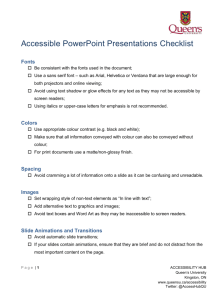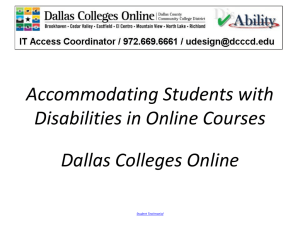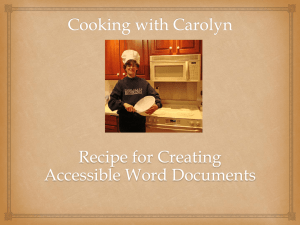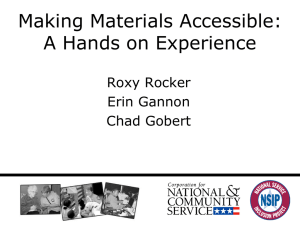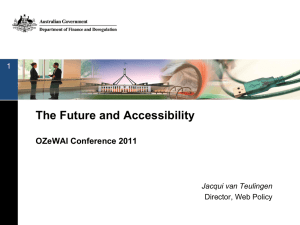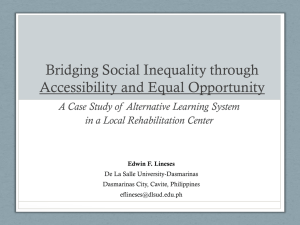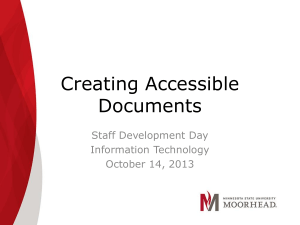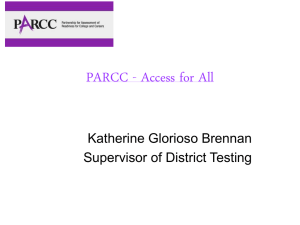Teaching accessibility and UD
advertisement
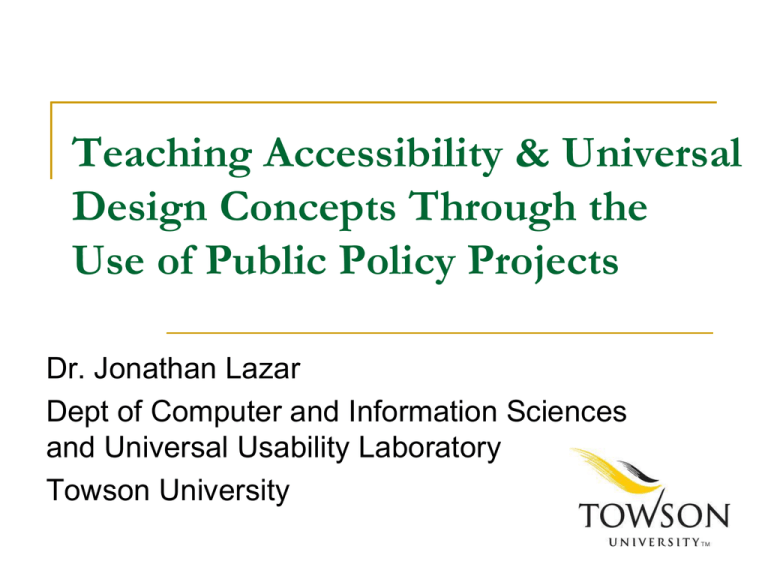
Teaching Accessibility & Universal Design Concepts Through the Use of Public Policy Projects Dr. Jonathan Lazar Dept of Computer and Information Sciences and Universal Usability Laboratory Towson University How do you structure a research paper assignment in a way that it: Is interesting to the students? Is unlikely to simply be copied from the Internet? Will actually help students understand concepts in a hands-on way? Will perform something useful for society? And also deal with the fact that… Much of the policymaking that occurs in the area of IT accessibility, is done using LITTLE TO NO EMPIRICAL DATA!!! Policymakers are starving for data to understand what’s going on! Old Research Paper Assignments Comic from http://www.anthonyarroyodotcom.com Human-Computer Interaction undergraduate class All Information Systems and Information Technology majors Students chose their own topic within HCI 10-12 page paper With citations and references New approach to research papers Class-wide public policy projects Students learn: 1. international guidelines related to web accessibility 2. how to evaluate web sites for accessibility 3. specific details of federal and state laws related to web accessibility The students then perform a series of accessibility inspections on a group of web sites that are required under law to be accessible Why this approach is better Students appreciate the hands-on nature of the evaluations Students are more engaged, since it’s useful writing for an external audience Students experience the relationship between law and human-computer interaction Students see that their work can have a real impact How the “Intro to HCI” class is structured Junior/Senior undergraduate level course Nearly all students come in with basic web programming skills Most students come in with no understanding of UD or HCI, and no background in the area of disability or accessibility I introduce the topics of web accessibility and public policy I ask students to utilize a screenreader (download when necessary) Students Learn Web Accessibility Public Policy Screen readers, captioning, and other types of assistive technologies WCAG 2.0 Section 508 Maryland IT Non-Visual Access Regulations Americans with Disabilities Act Students learn 1) who is legally required to be accessible and 2) what that means to be accessible Practice, practice, practice Students can’t just do an accessibility inspection for the first time and become confident and knowledgeable You need to do a LOT of exercises first! Start with the university home page, then departmental web pages, then local organizations that students are familiar with Encourage questioning and admitting confusion Method for the accessibility evaluations Use a screen reader, along with a written set of instructions on accessibility inspections 1. Listen to the web page being read out loud, while looking at the page 2. Use three common navigation methods: Headers Links lists Keyword searching 3. Check the web page code for compliance with each one of the legal paragraphs The evaluation covers more than just blind users Categories of potential study State or local government web sites University web sites Including course materials, videos, and lifecycle systems (applying to college, registering for classes, and applying for graduation) Local stores which would fall under legal requirements Public transportation (busses, subway, etc.) Public libraries Method for the evaluations Each web page gets 5 individual inspections from students Group meeting is held, where professor leads a discussion of the differences in each of the 5 inspections One student is the “lead” evaluator for that web page, and integrates the discussion into a meta-evaluation, summarizing all 5 reviews Be clear, that each individual evaluation won’t be perfect Also helps teach about why we do multiple reviewers Outcomes The class summarizes the data in a series of online spreadsheets The professor takes the leadership role on writing up the report (students comment on it) Final report is sent to appropriate local, state, or federal government officials Final report is also submitted for potential publication in a conference or journal, with all students as co-authors What happens if it doesn’t work? If students don’t follow through or take the evaluations seriously No report is written No data is sent outside of the class But students still get hands-on experience doing accessibility inspections So you can’t PROMISE a report to any outside entities before the semester is over with Previous Examples Job placement and travel web sites (Spring 2010) E-commerce web sites where there are webonly prices and also physical stores (Fall 2010) Maryland Public Library web sites (Spring 2011) Airline web sites (Fall 2009 and Fall 2011) Maryland state government web sites (Spring 2012) Suggestions for educators Undergraduate students are not immediately experts in something that they just learned, they need practice! There need to be pedagogical-related goals for these projects! The professor needs to check, and check, and re-check the data! Be aware of any potential politics


